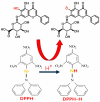Application of Natural Antioxidants as Feed Additives in Aquaculture: A Review
- PMID: 39857317
- PMCID: PMC11762552
- DOI: 10.3390/biology14010087
Application of Natural Antioxidants as Feed Additives in Aquaculture: A Review
Abstract
Oxidative stress, a critical factor affecting the health and productivity of aquatic organisms, arises from the imbalance between reactive oxygen species (ROS) production and antioxidant defenses. In aquaculture, natural antioxidants have gained increasing attention as sustainable feed additives to mitigate oxidative damage, enhance immune responses, and improve overall growth performance. This review provides a comprehensive synthesis of the antioxidative mechanisms of key natural antioxidants, including carotenoids, polysaccharides, vitamins, polyphenols, and flavonoids. By neutralizing ROS and modulating cellular signaling pathways such as Nrf2/ARE, these compounds offer significant protective effects against oxidative damage in aquatic species. The manuscript consolidates recent advancements in antioxidant research, highlighting their practical applications in feed formulation and their role in promoting sustainability in aquaculture. This review aims to provide an integrative framework for understanding natural antioxidants' potential, guiding future research and practical implementation in aquaculture systems.
Keywords: anti-stress; aquaculture; feed additives; growth; natural antioxidants; plants.
Conflict of interest statement
The authors declare no conflicts of interest.
Figures








References
-
- Bal A., Panda F., Pati S.G., Das K., Agrawal P.K., Paital B. Modulation of physiological oxidative stress and antioxidant status by abiotic factors especially salinity in aquatic organisms. Comp. Biochem. Physiol. Part C Toxicol. Pharmacol. 2021;241:108971. doi: 10.1016/j.cbpc.2020.108971. - DOI - PubMed
Publication types
Grants and funding
LinkOut - more resources
Full Text Sources

